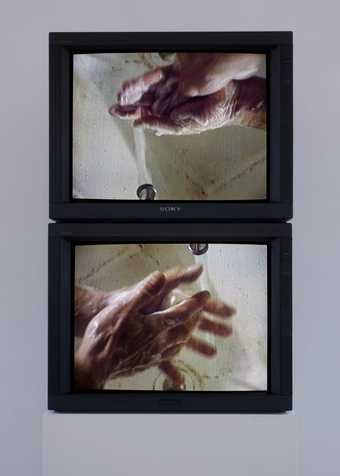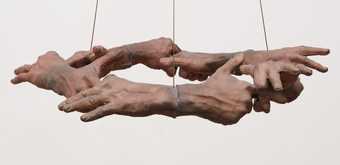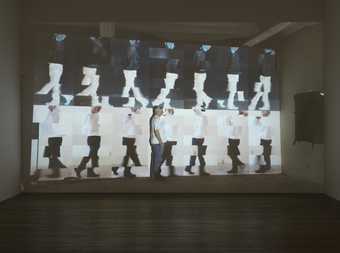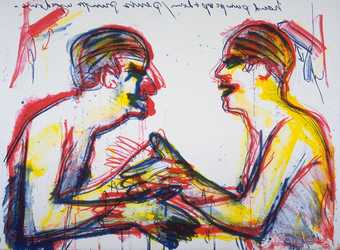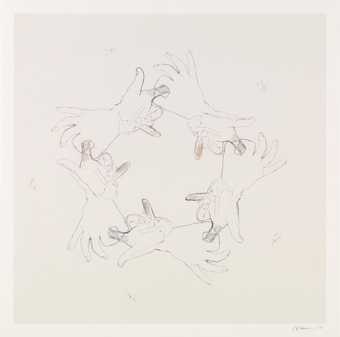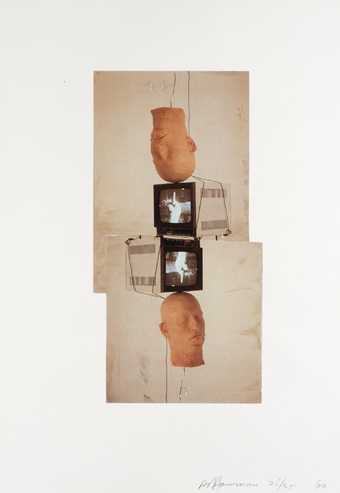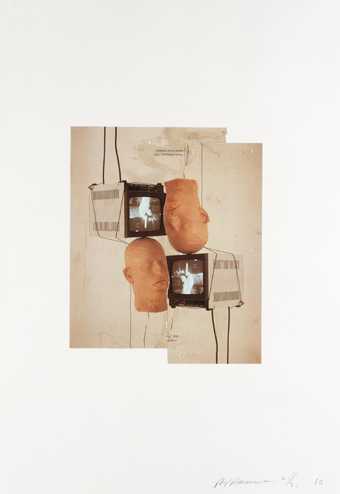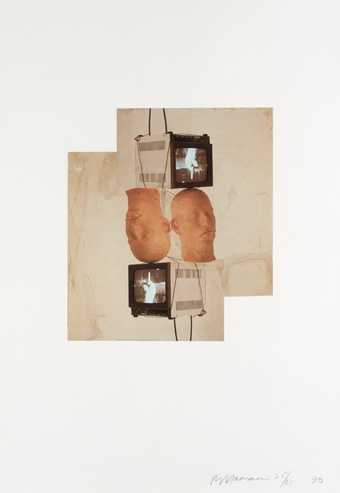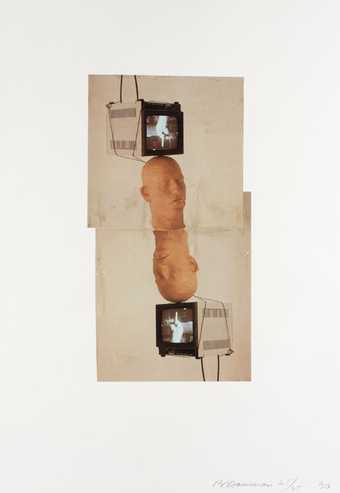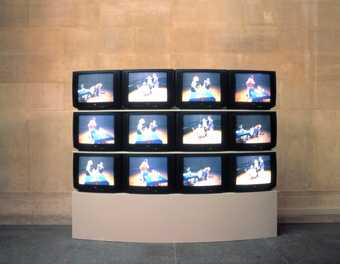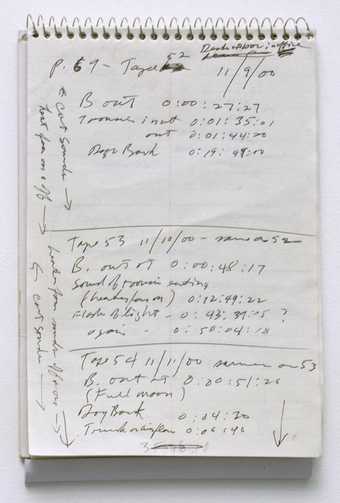Not on display
- Artist
- Bruce Nauman born 1941
- Medium
- Video, 7 projections, colour and sound (mono)
- Dimensions
- Duration: 5hours, 45min
Overall display dimensions variable - Collection
- Tate
- Acquisition
- Purchased jointly by Tate, London with funds provided by the American Fund for the Tate Gallery; Centre Pompidou, Musée national d'art moderne, Paris with the support of Mr and Mrs William S. Fisher Family Foundation and the Georges Pompidou Culture Foundation; and Kunstmuseum Basel, 2004
- Reference
- T11893
Summary
The two complex video installations titled Mapping the Studio I (Fat Chance John Cage) 2001 (Dia Foundation, New York) and Mapping the Studio II with color shift, flip, flop & flip/flop (Fat Chance John Cage) were created from material that suggested itself to the artist by chance. He has explained:
What triggered this piece were the mice. We had a big influx of field mice that summer in the house and in the studio ... They were so plentiful even the cat was getting bored with them ... I was sitting around the studio being frustrated because I didn’t have any new ideas, and I decided that you just have to work with what you’ve got. What I had was this cat and the mice, and I happened to have a video camera in the studio that had infrared capability. So I set it up and turned it on at night and let it run when I wasn’t there, just to see what I’d get ... I thought to myself why not make a map of the studio and its leftovers ... it might be interesting to let the animals, the cat and the mice, make the map of the studio. So I set the camera up in different locations around the studio where the mice tended to travel just to see what they would do amongst the remnants of the work.
(Quoted in AC: Bruce Nauman: Mapping the Studio I, p.11.)
Nauman filmed one hour per night intermittently over a period of several months to generate nearly forty-two hours of footage. He set up the camera at various locations, recording approximately six hours at each location. Simultaneously projected onto seven screens, this footage makes up Mapping the Studio I (Fat Chance John Cage), which lasts for nearly six hours (a single viewing day) and contains long periods in which nothing happens. The action is provided by the artist’s tailless cat, the mice and the occasional moth. Nauman thought of the areas he filmed as providing a kind of stage, on which it was ‘a matter of chance when the performers are going to show up and what is going to happen’ (quoted in Nauman, p.400). The American musician John Cage (1912-1992), whose work was based on indeterminacy and chance, was an important influence for Nauman. The phrase ‘fat chance John Cage’ in the title refers to an earlier work of Nauman’s, a telegram sent to the London gallerist Anthony d’Offay in response to a request for a work related to Cage. The telegram was misunderstood and was not exhibited; still intrigued by the expression ‘fat chance’, Nauman decided to reuse the words.
For Mapping the Studio II with color shift, flip, flop & flip/flop (Fat Chance John Cage), Nauman manipulated the footage used in the first work. The seven screens imperceptibly mutate in colour from red, to green, to blue, then back to red over fifteen or twenty minute periods which vary from screen to screen. At the same time the screens flip from left to right and top to bottom at approximately fifteen minute, non-synchronised intervals. The sound is the real-time ambient noise of wind, rain, horses whinnying, dogs barking, coyotes howling, the cat meowing and the whistle of a distant train, reflecting the studio’s rural setting in Galisteo, New Mexico. Dramatically amplified, these incidental sounds are distorted to become a sinister background drone. The use of ambient sound, like that of the uncontrollable animal performers, may be understood as a Cagean device.
Mapping the Studio recalls Nauman’s work of the late 1960s, in which he used his studio as the stage for a series of repeated simple, and often banal, actions, which he recorded on 16mm film. However the mood, which combines humour with violence, recalls the artist’s more recent work. Like the cat and mouse cartoons, Tom and Jerry, first produced between1940 and 1958 by Metro-Goldwin Mayer, Nauman’s installations have an apparently light-hearted and even comic appearance which masks a disturbing relationship – that of the predator and its prey. Long periods of non-action result in a tense and sinister atmosphere. In the second version, the manipulation of the screen orientation and colours has a disturbing effect. Nauman has used clowns in numerous works for their universality and masked anonymity in order to heighten an underlying sense of violence. In a similar way, the animals in the Mapping the Studio works are familiar but anonymous characters evoking the fragility and instinctive cruelty of life.
Two further Mapping the Studio video works exist: Mapping the Studio I (Fat Chance John Cage) All Action Edit 2001 (Friedrich Christian Flick Collection, Hamburger Bahnhof, Berlin) and Mapping the Studio II with color shift, flip, flop & flip/flop (Fat Chance John Cage) All Action Edit 2001 (Walker Art Centre, Minneapolis) are, as the titles indicate, edited versions. Ranging from half and hour to just over one hour, they feature the filmic ‘action’ of the longer works. Mapping the Studio Notebook (Book I) and (Book II) (Tate L02512 and L02513) are the notepads on which the artist logged the activity recorded each night by his video camera.
Further reading:
AC: Bruce Nauman: Mapping the Studio I (Fat Chance John Cage), exhibition catalogue, Museum Ludwig, Cologne 2003
Bruce Nauman: Mapping the Studio, exhibition catalogue, Museum für Gegenwartskunst Basel 2003, reproduced in colour on 13 pages in folded insert behind title page
Bruce Nauman: Mapping the Studio I (Fat Chance John Cage), exhibition brochure, Dia Centre for the Arts, New York 2002
Elizabeth Manchester
October 2004
Does this text contain inaccurate information or language that you feel we should improve or change? We would like to hear from you.
Explore
- architecture(30,960)
- industrial(2,075)
-
- studio(44)
- emotions and human qualities(5,345)
-
- boredom(50)
- creativity(1,349)
- inspiration(36)
- classification(114)
- colour(836)
- photographic(4,673)
- environment / nature(315)
- ephemerality(51)
- existence(292)
- humour(1,441)
- workspaces(918)
-
- studio(549)
- cities, towns, villages (non-UK)(13,323)
-
- Galisteo(2)
- USA(622)
You might like
-
Bruce Nauman Setting a Good Corner (Allegory and Metaphor)
1999 -
Bruce Nauman Washing Hands Normal
1996 -
Bruce Nauman Untitled (Hand Circle)
1996 -
Bruce Nauman Walks In Walks Out
2015 -
Bruce Nauman Untitled
1994 -
Bruce Nauman Untitled
1994 -
Bruce Nauman [title not known]
1990 -
Bruce Nauman [title not known]
1990 -
Bruce Nauman [title not known]
1990 -
Bruce Nauman [title not known]
1990 -
Bruce Nauman All Thumbs Holding Hands
1998 -
Bruce Nauman Violent Incident
1986 -
Bruce Nauman Good Boy Bad Boy
1985 -
Bruce Nauman MAPPING THE STUDIO Notebook (Book 1)
2001 -
Bruce Nauman MAPPING THE STUDIO Notebook (Book 2)
2001



